Overview
Software development in banking is pivotal for optimizing financial transactions and enhancing customer engagement, driven by the pressing needs for efficiency, security, and regulatory compliance. As banks face the challenge of outdated legacy systems, transitioning to modern solutions—such as cloud-based platforms and AI-driven technologies—becomes essential. This shift not only improves operations but also allows banks to meet the evolving expectations of customers in a fiercely competitive landscape.
Are you ready to embrace these advancements and elevate your banking services? The integration of these technologies is not just a trend; it is a necessity for future success.
Introduction
In an era defined by digital transformation, software development stands as a pivotal force reshaping the banking landscape, driving efficiency, security, and customer satisfaction. Financial institutions face significant challenges posed by outdated legacy systems and the urgent need to innovate within an intensely competitive environment.
With nearly 60% of banking leaders identifying legacy infrastructure as a barrier to growth, the transition towards agile, cloud-based solutions is no longer a mere trend—it is an essential strategy. As banks adopt groundbreaking technologies such as artificial intelligence and blockchain, they are reimagining customer interactions and optimizing operations to meet the evolving demands of their clientele.
This article explores the intricate realm of banking software development, examining current trends, key technologies, and the transformative effects of innovative solutions on the future of financial services.
Understanding Software Development in the Banking Sector
Software development in banking encompasses the design, testing, and maintenance of applications and systems that support financial transactions and services. This field includes a wide array of solutions, from core financial systems managing customer accounts and transactions to mobile applications that enhance customer engagement. The drive for improved efficiency, security, and compliance with regulatory standards primarily motivates the development of these financial applications.
With nearly 60% of financial leaders identifying legacy infrastructure as the primary barrier to business growth, transitioning from outdated systems to agile, cloud-based solutions has become imperative. This shift not only optimizes operations but also significantly enhances customer experience, making robust development practices a critical focus for modern financial institutions. Avato’s hybrid integration platform is pivotal in this transition, maximizing and extending the value of legacy systems while simplifying complex integrations, ultimately leading to cost reduction.
Recent trends reveal an increasing dependence on innovative technologies, such as generative AI, which is being explored to upgrade legacy mainframes at scale. By automating the integration of microservice-based applications and rewriting outdated code, banks can bolster their modernization efforts, ensuring compatibility with contemporary systems. A compelling case study illustrates how generative AI facilitates the assessment of existing banking systems, prepares data for core conversions, and automates integration processes, thereby significantly enhancing the modernization journey.
Expert insights underscore the crucial role of software development in banking within the financial services sector. Val Srinivas, Senior Research Leader at the Deloitte Center for Financial Services, asserts that “the ability to adapt to technological advancements is crucial for banks to remain competitive and meet customer expectations.” Vikram Bhat, Vice Chair and US Financial Services Industry Leader at Deloitte, emphasizes that strategic change and technology application are essential for navigating the industry’s complexities.
Moreover, the integration of advanced software solutions, such as Avato’s secure hybrid integration platform, is vital for sustaining operational efficiency and competitiveness in an ever-evolving market.
Avato is committed to delivering a reliable integration platform with a promise of 24/7 uptime, ensuring that financial operations proceed without interruptions. The platform also provides real-time monitoring and alerts on system performance, empowering banks to proactively manage their systems and enhance service delivery.
In summary, the impact of software development in banking on the efficiency of financial institutions is profound, with statistics indicating that effective program solutions can lead to substantial cost reductions and improved service delivery. As the financial industry continues to embrace digital transformation, the importance of software development in banking will only escalate, shaping the future of financial services. Avato’s market differentiation, marked by speed, security, and simplicity in integration, positions it as a key player in supporting banks through this transformative journey.
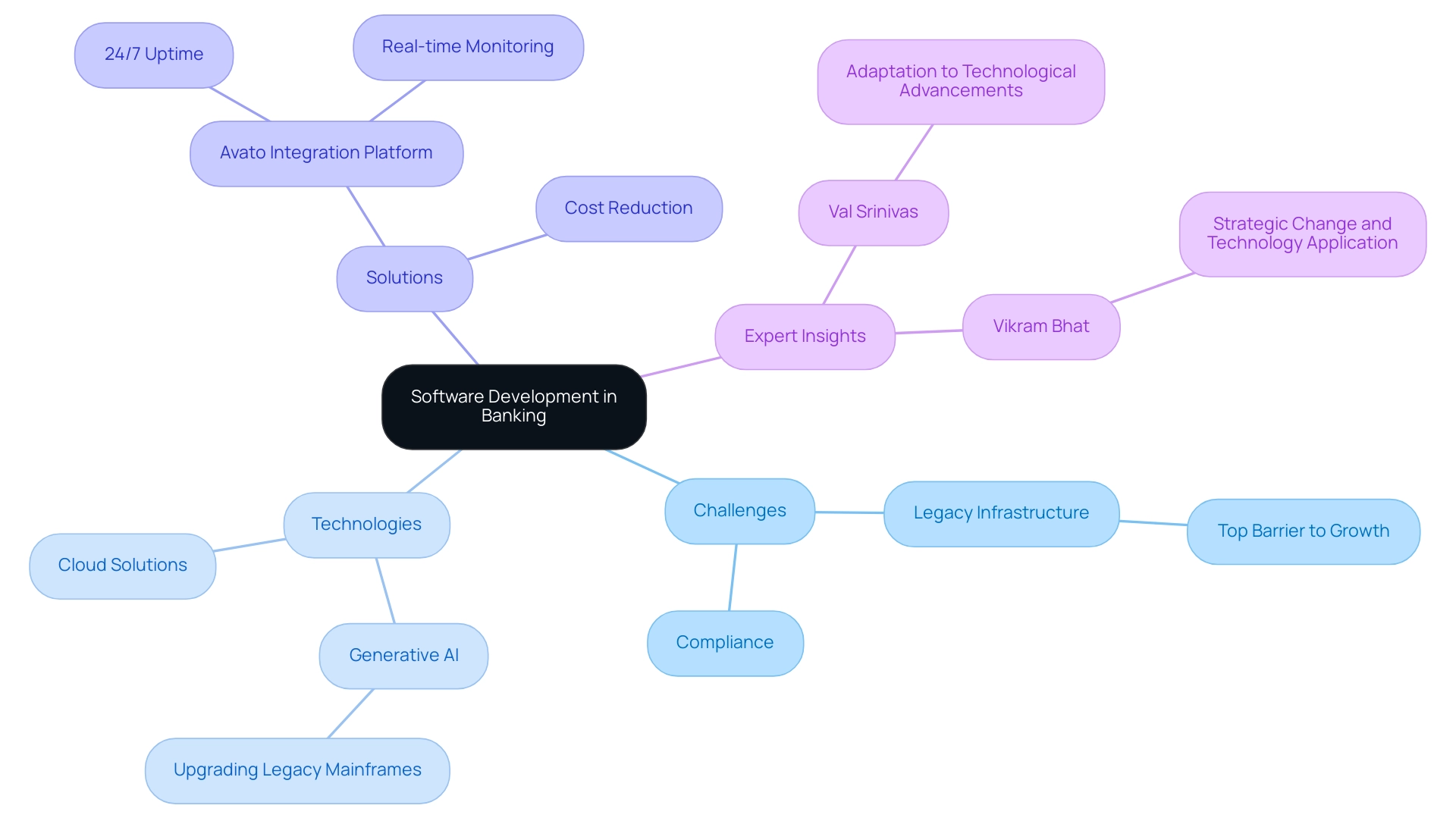
Current Trends Shaping Banking Software Development
The landscape of software development in banking is currently being shaped by several pivotal trends. A primary driver is the integration of artificial intelligence (AI), particularly generative AI, which is transforming service through the deployment of sophisticated chatbots and virtual assistants, significantly enhancing the customer experience. With 80% of consumers expressing a preference for tailored financial services, financial institutions are increasingly leveraging data analytics and AI to create personalized experiences that boost engagement and satisfaction.
A recent survey indicates a 60% increase in the use of generative AI for client experience, underscoring its importance in developing innovative solutions.
Furthermore, open banking initiatives are gaining momentum, supporting software development in banking by allowing third-party developers to create innovative applications that enrich financial services. This transition not only promotes competition but also stimulates cooperation between conventional financial institutions and FinTech firms, resulting in a more vibrant marketplace. Additionally, the emphasis on cybersecurity has increased, urging financial organizations to invest significantly in sophisticated security measures to protect sensitive client information.
As cyber threats evolve, maintaining robust security protocols is essential for building customer trust and ensuring compliance with regulatory standards.
The adoption of cloud computing is another significant trend, enabling financial institutions to scale operations efficiently while reducing costs associated with maintaining on-premises infrastructure. This transition supports greater flexibility and responsiveness to market demands.
As we move into 2025, the financial sector is also witnessing a shift towards composable architectures in software development in banking, where modular solutions can be integrated seamlessly. This approach not only enhances operational efficiency but also allows financial institutions to adapt quickly to changing consumer preferences and regulatory requirements. The proposed modifications to capital requirements are anticipated to lead to a 9% rise in common equity tier 1 for global systemically important institutions, further highlighting the necessity for strategic financial management.
Avato plays a crucial role in this transformation by simplifying complex integrations and delivering cost-effective solutions that enhance software development in banking, supporting secure transactions across financial services, healthcare, and government sectors. Avato’s platform supports 12 levels of interface maturity, allowing financial institutions to balance speed of integration with the sophistication required to future-proof their technology stack. As noted by Gustavo Estrada, a customer of Avato, the platform’s ability to streamline integration projects and ensure 24/7 uptime is vital for financial institutions navigating these evolving challenges.
Additionally, integrating risk controls into transformation initiatives is essential for mitigating risks and ensuring compliance with regulations, underscoring the comprehensive approach needed in the modern financial landscape.
In summary, these trends collectively indicate a significant shift towards more customer-centric, secure, and flexible financial solutions, positioning institutions to thrive in an increasingly competitive environment.

Exploring Different Types of Banking Software Solutions
Software development in banking encompasses a range of solutions tailored to meet the critical operational needs of financial institutions. At the core of these developments are essential financial systems, which are vital for managing daily activities such as account management, transaction processing, and compliance reporting. These systems empower financial institutions to operate efficiently, delivering seamless services to their clients.
Furthermore, payment processing platforms are pivotal in facilitating secure and efficient transactions, whether online or offline. These platforms ensure that financial transactions are executed promptly and safely, bolstering client trust and satisfaction.
Client relationship management (CRM) systems represent another essential component, enabling financial institutions to manage interactions and data effectively. By leveraging CRM systems, institutions can enhance service delivery and foster stronger client relationships, ultimately driving increased customer loyalty.
Moreover, software development related to risk management is crucial for identifying and mitigating potential financial risks, allowing institutions to protect their assets and maintain stability in a dynamic market. Regulatory compliance tools further support the software development process by ensuring adherence to legal requirements and minimizing the risk of penalties.
As financial entities prepare for the transition to open finance, strategic integration approaches in software development become paramount. Banks must leverage existing legacy systems rather than discarding them, utilizing middle layers to facilitate communication in open formats. This strategy not only preserves valuable assets but also enhances overall integration, ensuring secure and efficient data sharing.
The significance of regulatory compliance and security audits in Avato’s hybrid integration solutions cannot be overstated. As software development in banking introduces new data-sharing opportunities through open financial services, it also increases the risk of security breaches. Therefore, institutions must ensure that their software development incorporates integration solutions that comply with stringent security protocols to safeguard consumer data and maintain trust.
Looking ahead to 2025, the software development landscape in banking continues to evolve, with a notable shift towards biometric authentication methods. Recent statistics reveal that 46% of U.S. companies are replacing traditional passwords with biometric solutions, underscoring a growing emphasis on security in financial operations. Additionally, incorporating risk and compliance into transformation initiatives is becoming increasingly vital, assisting institutions in mitigating risks and eliminating inefficiencies that can escalate operating costs.
The core financial system market is also witnessing significant advancements, with leading institutions currently holding a mere 32% market share in wealth management. This presents growth opportunities amidst challenges such as rising competition and regulatory scrutiny regarding fee transparency. A recent survey indicated that only 36% of respondents were satisfied with their fee structures, highlighting the urgent need for institutions to enhance transparency and address customer concerns.
As financial institutions navigate these dynamics, implementing robust core financial systems will be essential for maintaining a competitive edge through software development and ensuring operational efficiency. Furthermore, 68% of respondents believe that alternative capital providers will gain importance post-pandemic, emphasizing the necessity for institutions to adapt to this evolving landscape.
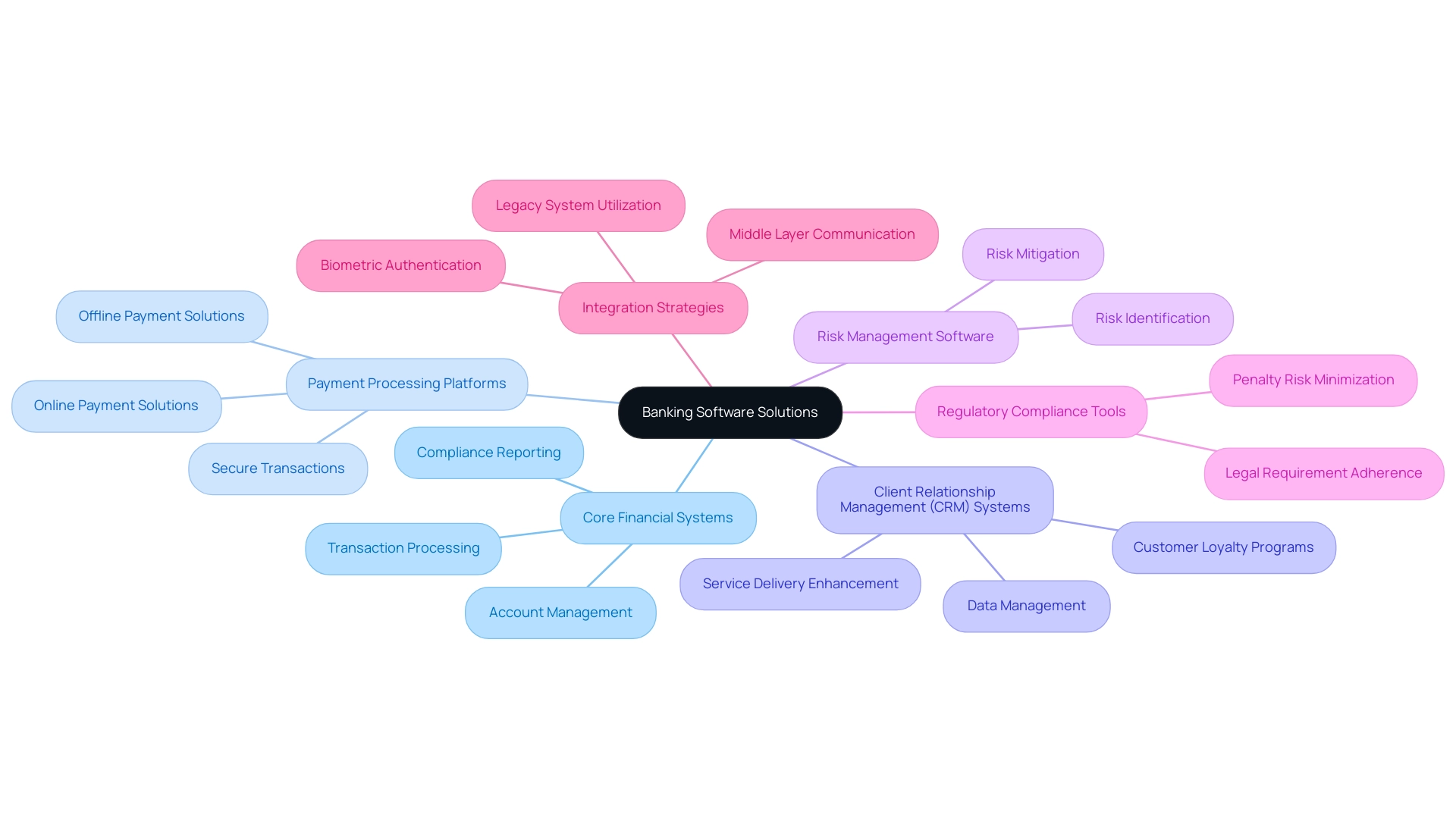
Key Technologies Revolutionizing Banking Software
Several key technologies are revolutionizing software development in banking, significantly enhancing operational efficiency and security.
- Blockchain technology stands out for its ability to bolster security and transparency in transactions, making it an invaluable asset for fraud prevention and regulatory compliance. Notably, one-third of executives have identified security concerns as a major barrier to blockchain adoption, underscoring the critical need for robust solutions in this area.
- Cloud computing is another transformative force, enabling financial institutions to store and process data more efficiently. This technology not only supports scalability and flexibility in operations but also reduces costs associated with traditional infrastructure. For instance, case studies have shown that financial institutions leveraging cloud solutions can achieve significant improvements in data management and operational agility.
- Machine learning algorithms are increasingly being integrated into financial systems for predictive analytics, allowing organizations to assess credit risk and detect fraudulent activities in real-time. This capability is crucial in today’s fast-paced financial landscape, where timely decision-making can reduce risks and strengthen client trust.
- Moreover, application programming interfaces (APIs) are enabling seamless integration between various financial systems and third-party applications. This integration encourages innovation and improves client experiences by allowing financial institutions to provide more tailored services and optimize operations.
As we approach 2025, the influence of blockchain technology on financial applications is anticipated to increase, with progress in security and efficiency leading to further adoption. The combination of these technologies is not only transforming how financial institutions operate but also reshaping their interactions with customers and data management practices, which is vital for software development in banking to ensure they remain competitive in an evolving landscape. In this context, the strategic importance of XML technologies cannot be overlooked; XML ensures data interoperability and longevity, making it a critical component of modern banking software solutions.
XML’s structured format allows for clear data representation, while its extensibility enables the integration of new data types without disrupting existing systems.
Avato’s Hybrid Integration Platform exemplifies how to maximize the value of legacy systems while simplifying complex integrations. Designed for secure transactions, Avato is relied upon by financial institutions, healthcare, and government sectors, ensuring 24/7 uptime and reliability. The platform’s ability to handle complex systems securely and efficiently is vital for digital transformation initiatives.
Furthermore, Avato’s solutions, as highlighted by Gustavo Estrada, demonstrate effectiveness in addressing the challenges faced by traditional banks competing with FinTech startups. The case analysis on StatCan’s technical solution for document authentication demonstrates how technology can improve security and trust in financial applications, emphasizing the need for innovation in this competitive environment. Additionally, the use of XML within Avato’s platform allows for seamless data exchange and integration, showcasing its practical application in enhancing operational efficiency.
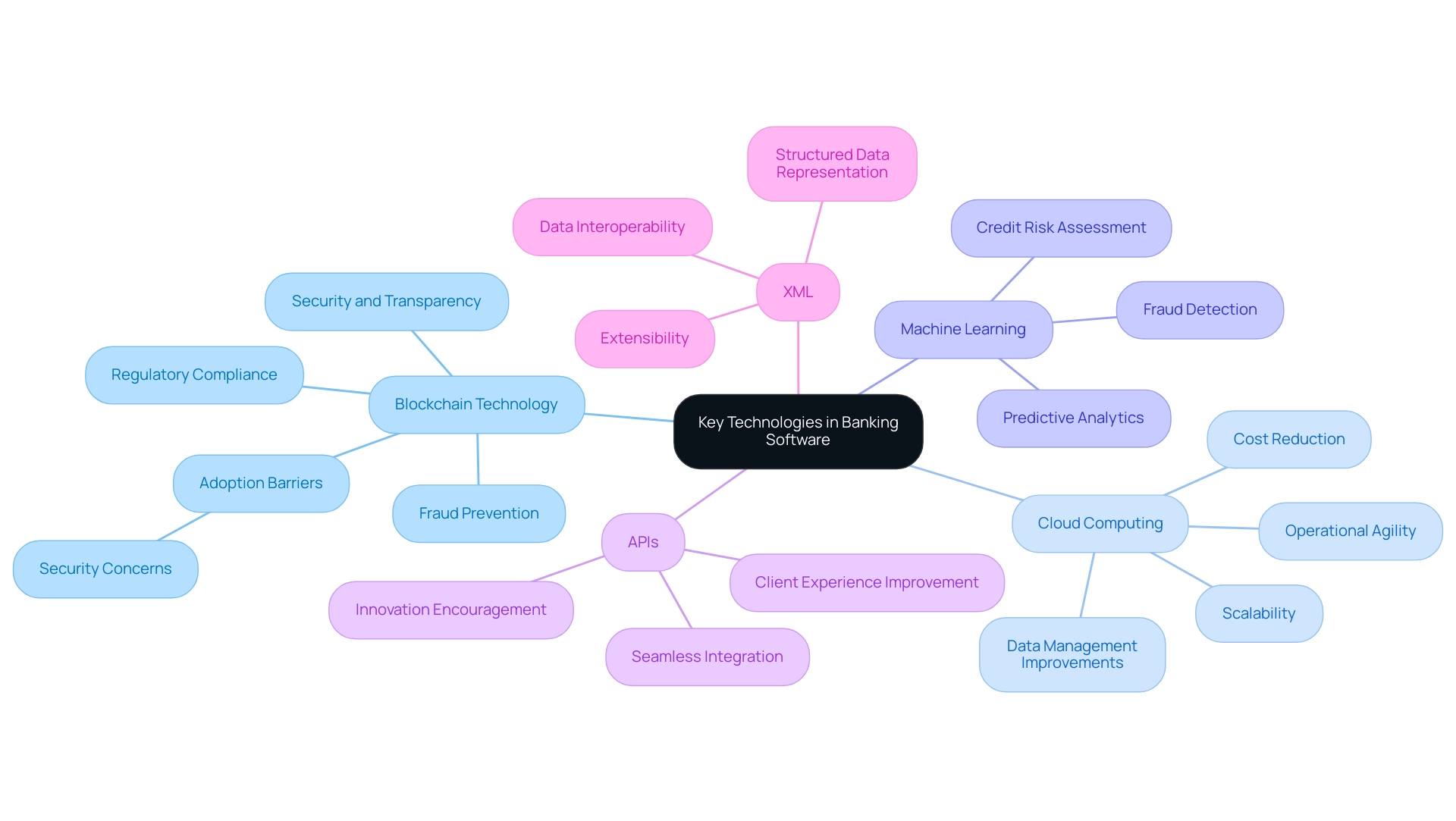
Enhancing Customer Experience Through Software Development
Improving client experience is a cornerstone of software development in banking. With the growing demand for intuitive and efficient services, financial institutions are increasingly embracing user-centric design principles, now enhanced by the transformative capabilities of artificial intelligence (AI). This approach prioritizes the creation of interfaces that simplify navigation and streamline transaction processes, ultimately leading to a more satisfying user experience.
Key features such as personalized dashboards, real-time notifications, and seamless onboarding processes are instrumental in engaging customers. The incorporation of generative AI tools, which 52% of financial services professionals reported using in 2025, enables institutions to provide customized financial advice and support through AI-driven chatbots and virtual assistants. These elements not only make banking more accessible but also empower users to manage their finances effectively. Moreover, the inclusion of feedback systems allows financial institutions to adjust and enhance their services based on direct client input, promoting a culture of ongoing improvement.
The influence of user-focused design on client loyalty and satisfaction cannot be overstated. Research indicates that 62% of consumers desire personalized interactions that provide tangible economic value, such as cost savings or rewards. This emphasizes the necessity for banks to align their services with client expectations to cultivate lasting relationships. Additionally, only 20% of consumers would forgive a company after a bad experience if they rated previous service as ‘very poor,’ underscoring the importance of maintaining high service standards in software development in banking. As noted by the Qualtrics XM Institute, nearly 80% would forgive a bad experience if they considered the service ‘very good,’ reinforcing the significance of delivering excellent service.
Case studies illustrate the effectiveness of these design principles in enhancing user experience. For example, financial institutions that have adopted user-focused strategies report notable enhancements in client satisfaction and retention rates. One such case study emphasizes the importance of aligning financial institution values with those of their customers, demonstrating how supporting local charities and offering loyalty perks can strengthen emotional bonds.
By prioritizing user experience and integrating AI-driven solutions, banks not only drive revenue growth—evidenced by nearly 70% of firms reporting revenue increases due to AI—but also position themselves as leaders in an increasingly competitive market. As we progress deeper into 2025, the focus on user-centric design, supported by AI integration, will continue to be crucial in shaping the future of software development in banking.
To explore how Avato can assist your organization in harnessing these AI capabilities for enhanced customer experience and operational efficiency, connect with us today. Our customized AI evaluation is created to offer you insights and strategies to enhance your financial solutions.
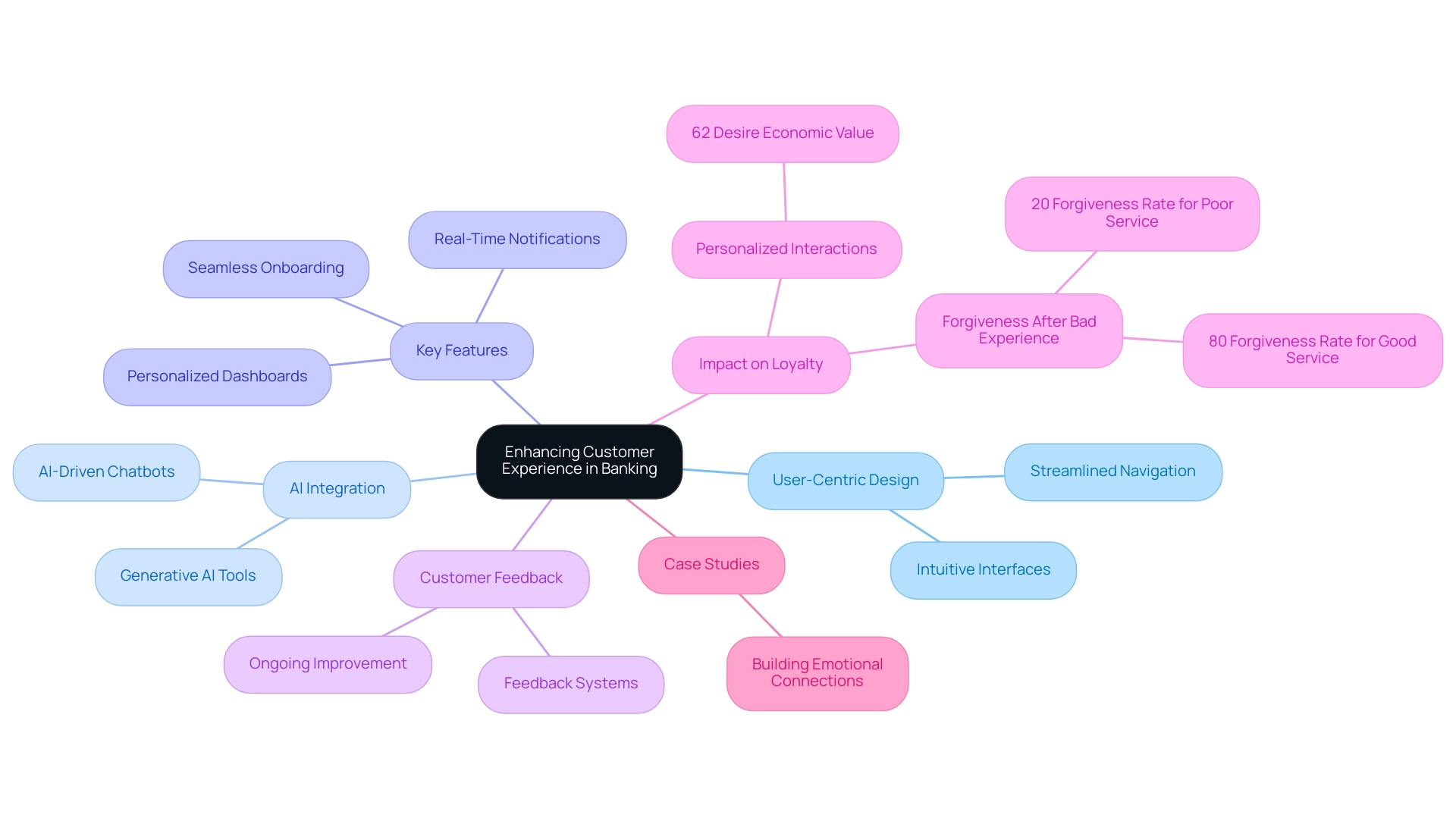
Navigating Regulatory Compliance in Banking Software Development
Navigating regulatory compliance poses a formidable challenge in software development within the banking sector. Financial institutions must adhere to a complex array of regulations, including anti-money laundering (AML) and know your customer (KYC) mandates, alongside stringent data protection laws. In 2025, a striking 67% of global executives report finding ESG regulations particularly complex, underscoring the pressing need for clarity in compliance requirements.
Compliance management software from Avato emerges as a vital tool in this landscape, automating compliance checks and reporting processes to ensure that financial institutions fulfill their legal obligations efficiently. How can organizations leverage such technology to enhance their compliance strategies?
To optimize integration strategies, it is crucial for financial institutions to mobilize stakeholders effectively, ensuring that requirements are accurately captured from the outset. Utilizing the right technology and tools can help illustrate both the current state and the ideal state of compliance processes. This proactive approach not only aids in modeling new business processes and activity flows but also charts a clear course to success in compliance management.
Furthermore, the integration of robust security measures, such as encryption and multi-factor authentication, is essential for safeguarding sensitive customer data. A staggering 35% of business and tech executives identify third-party breaches as one of the most concerning cyber threats, highlighting the critical need for effective vendor risk management. As Accenture notes, “52% of compliance experts claim that insufficient data and information about partners expose businesses to third-party risks,” emphasizing the importance of thorough vendor assessments.
By prioritizing compliance within their software development frameworks, banks not only mitigate risks but also enhance their market reputation. Moreover, organizations must leverage technology and best practices to improve compliance efficiency. Statistics reveal that 73% of risk identification efforts focus on due diligence and recertification, indicating a shift towards proactive compliance strategies. Case studies illustrate that many firms have successfully implemented third-party due diligence programs, significantly reducing legal, financial, and reputational risks, although ongoing monitoring and compliance audits remain areas for improvement.
For instance, organizations face heightened risks when outsourcing tasks to third-party vendors, with many having experienced breaches linked to these partners. As the regulatory environment continues to evolve, the effect of AML and KYC adherence on software development in banking will be significant, necessitating a progressive approach to integration and compliance management.
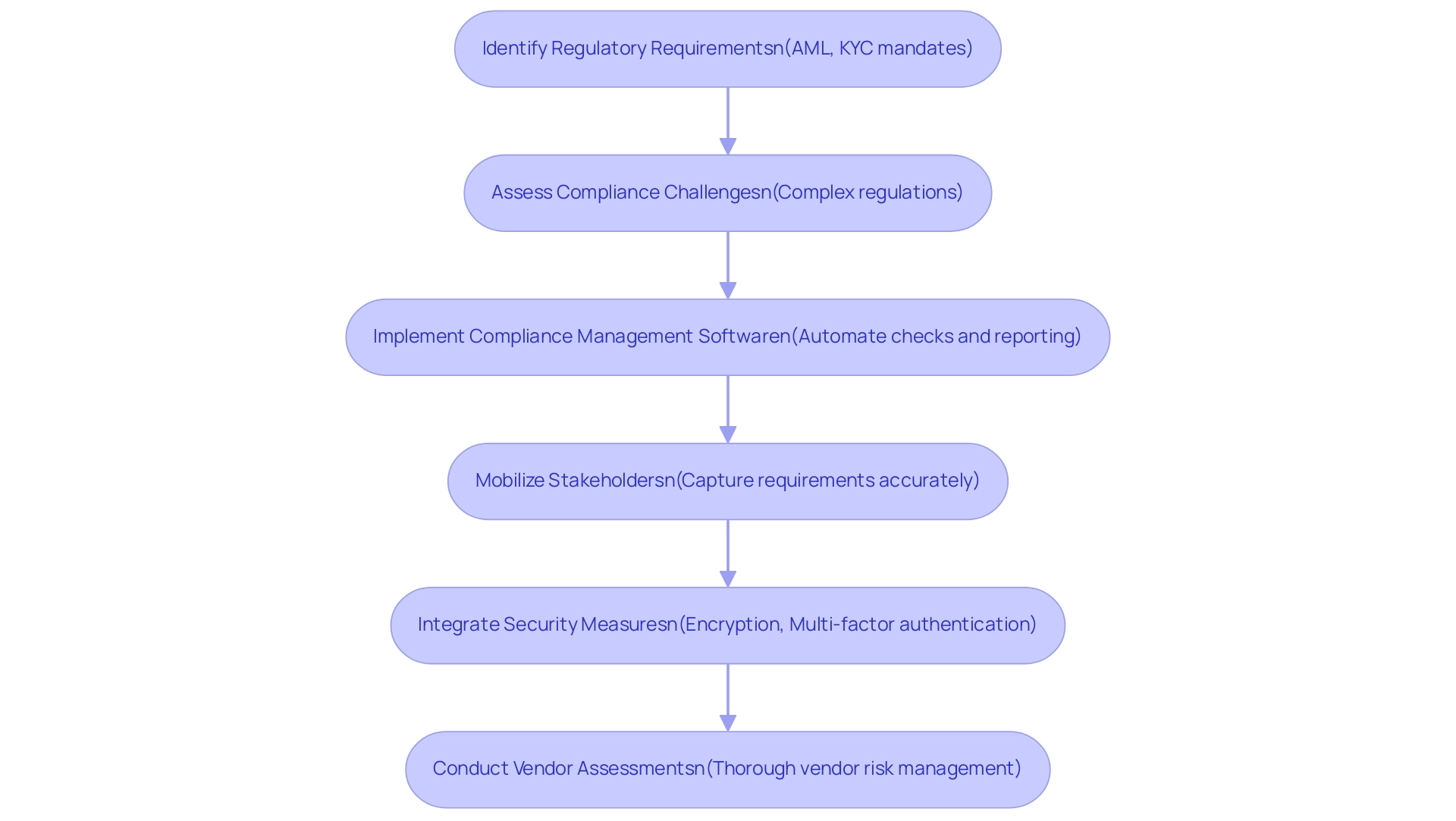
Budgeting for Custom Banking Software Development
Budgeting for software development in banking necessitates a thorough evaluation of several critical factors, including project scope, technology stack, and development timelines. Banks must account for both the initial costs of software development and the ongoing maintenance expenses that will arise post-launch. A prudent approach involves allocating a contingency budget to address unforeseen costs that may emerge during the development process.
Collaborating with experienced development partners, such as Avato, can yield valuable insights into cost-effective solutions and best practices, ultimately enhancing the budgeting process. Avato’s commitment to architecting the technology foundation necessary to power rich, connected experiences is reflected in its hybrid integration platform. This platform enables businesses to future-proof their operations through seamless data and system integration, ensuring that financial institutions navigate the complexities of application development while maintaining compliance with regulations and customer trust.
As Marcus Schwarz observes, “The digital financial sector faces both challenges and opportunities,” underscoring the necessity for institutions to emphasize innovation and security.
Furthermore, as the digital financial environment transforms, it is anticipated that 32.6 million Americans will adopt remote work by 2025. This trend highlights the necessity for adaptable and scalable technology solutions. Significantly, over 60% of outsourcing services pertain to application development, emphasizing the importance of collaborating with skilled developers. The integration of AI and automation is also revolutionizing software development in banking, simplifying repetitive tasks and allowing developers to focus on more complex issues. This shift can lead to more efficient budgeting and resource allocation.
The case study titled “Conclusion on Digital Banking Sector” illustrates that successful players in the digital banking market are those who can integrate emerging technologies, such as generative AI, while maintaining client trust and compliance with regulations. By creating a clear budget and diligently tracking expenses throughout the project lifecycle, financial institutions can ensure that their initiatives in software development remain aligned with financial constraints. This strategic approach not only mitigates risks but also enables banks to capitalize on the opportunities created by advancements in technology and evolving market dynamics, particularly through the transformative effect of AI on trading, client engagement, and security.
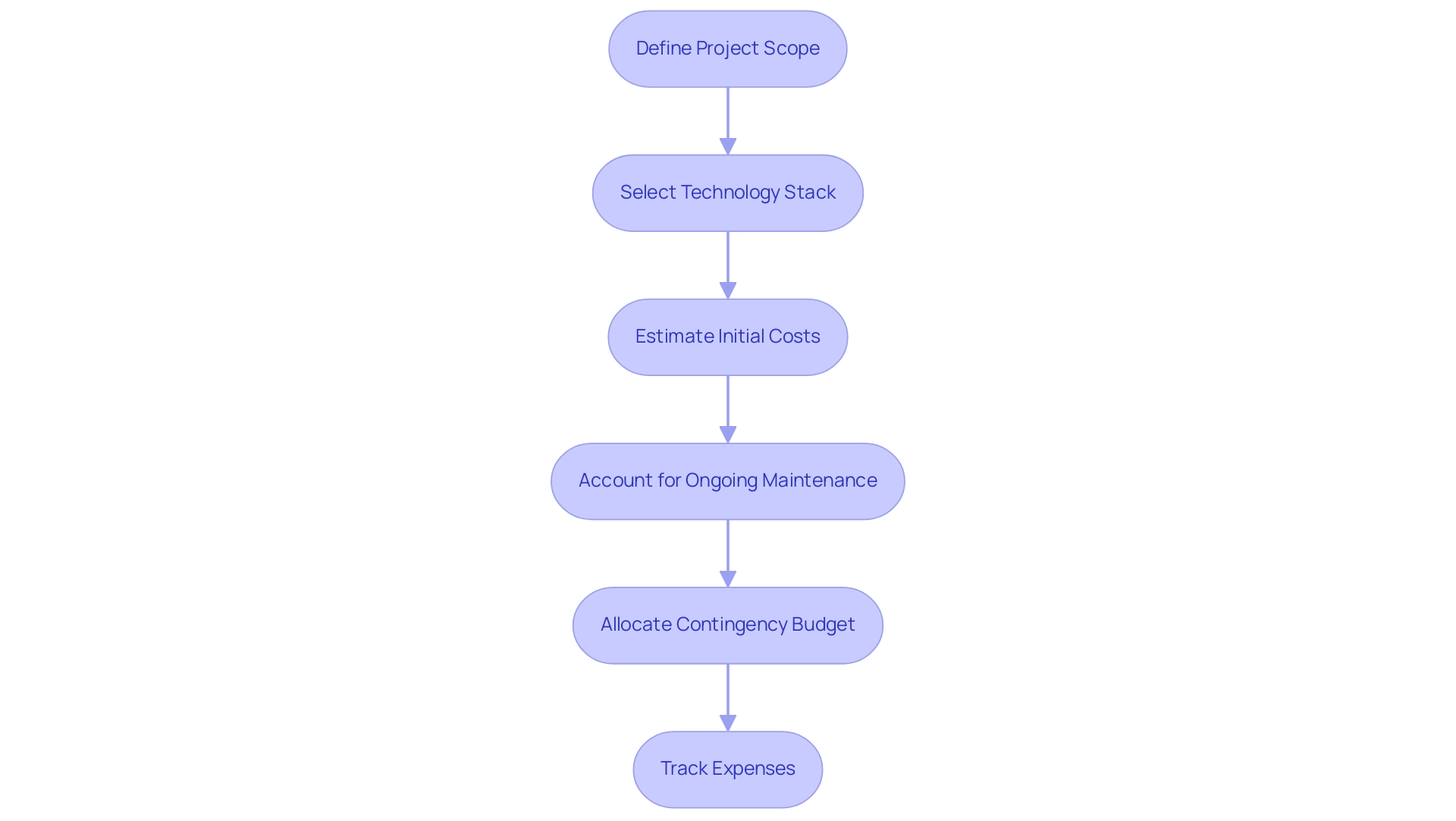
The Future of Software Development in Banking
The future of software development in banking is poised for a remarkable transformation, propelled by rapid technological advancements and the pioneering efforts of companies like Avato. Financial institutions are increasingly leveraging artificial intelligence (AI) and machine learning (ML) to enhance decision-making processes and elevate customer service experiences. By 2025, nearly 46% of companies in the U.S. are expected to adopt biometric authentication methods, reflecting a broader trend towards more secure and user-friendly financial solutions.
Furthermore, the rise of open finance is a pivotal factor driving innovation within the sector. As of 2023, over 60 nations have established or are in the process of establishing open financial regulations, mandating banks to share client data with third-party providers through secure APIs. This shift not only fosters collaboration but also facilitates the creation of new financial products and services tailored to meet evolving client needs.
In addition, the integration of blockchain technology is anticipated to revolutionize banking operations by enhancing security and streamlining processes. As customer expectations increasingly lean towards personalized and seamless experiences, financial institutions must prioritize user-centric design in their software development strategies. This approach will ensure they remain competitive in a landscape characterized by rapid change and heightened consumer demands.
As financial institutions recalibrate their business models to adapt to a challenging macroeconomic environment projected for 2025, which includes lower interest rates and modest economic growth, innovative strategies become essential. The case study titled “Banking Sector Adaptation to Macroeconomic Conditions” illustrates how institutions are preparing for these challenges by focusing on boosting non-interest income and managing costs effectively. By incorporating risk and compliance into transformation initiatives, financial institutions can achieve sustainable cost reductions while enhancing profitability.
Avato’s hybrid integration solutions empower financial institutions to lead the AI revolution, utilizing generative AI to improve user experience and operational efficiency. Embracing AI and ML not only positions banks to tackle current challenges but also equips them to thrive in the future, ultimately enhancing operational capabilities and customer satisfaction. According to World Metrics, the global digital banking market is projected to reach $22.3 trillion by 2026, underscoring the significant opportunities that lie ahead.
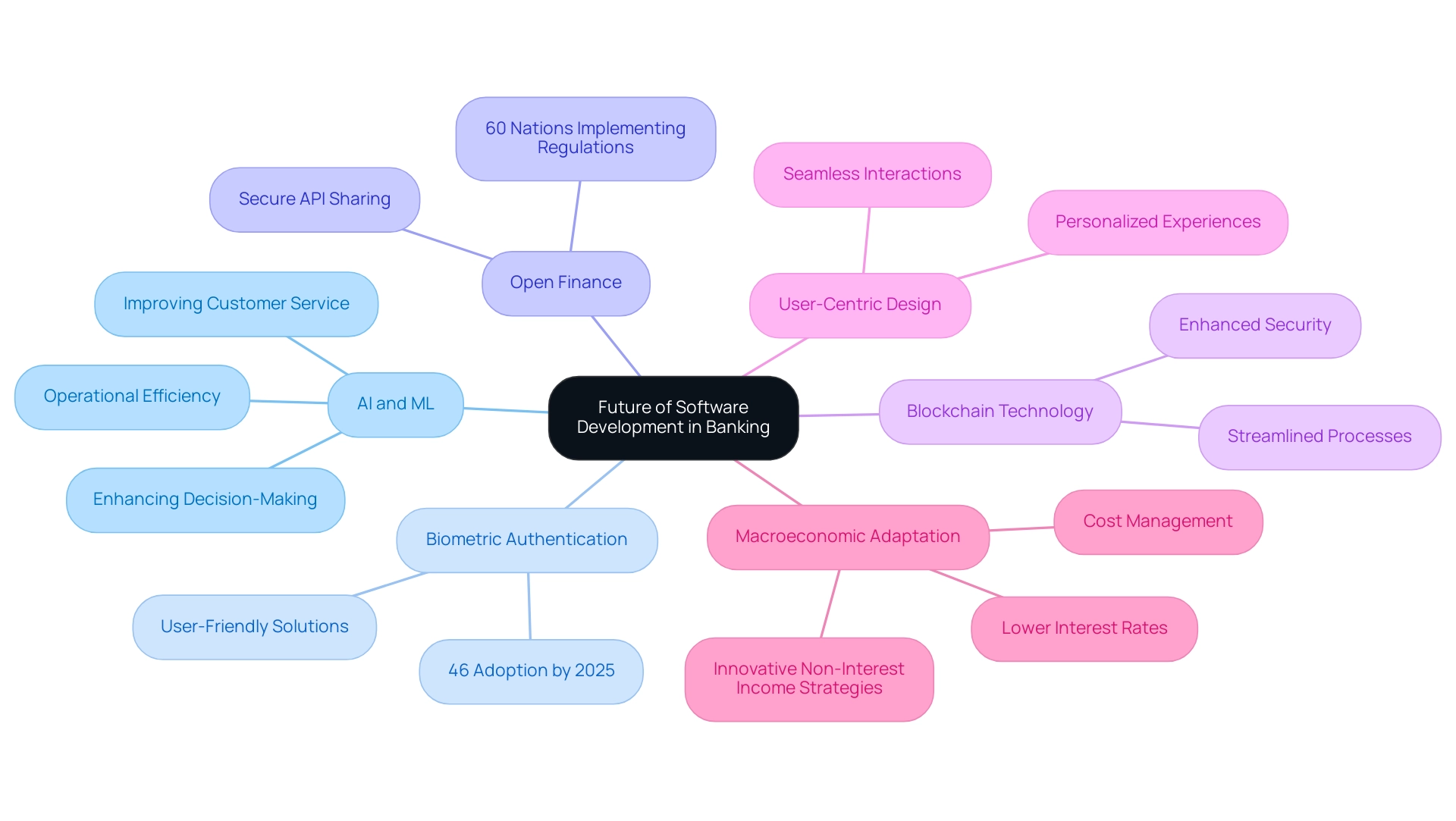
Conclusion
The evolution of banking software development is reshaping the financial landscape, focusing on overcoming the limitations of legacy systems and embracing modern technologies. The integration of artificial intelligence, cloud computing, and blockchain technology is not merely enhancing operational efficiency; it is fundamentally transforming customer experiences. With nearly 60% of banking leaders recognizing outdated infrastructure as a barrier, the shift towards agile, cloud-based solutions is imperative for maintaining competitiveness.
Current trends emphasize customer-centric approaches, driven by the demand for personalized services and robust security measures. The implementation of generative AI and open banking initiatives fosters innovation and collaboration, enabling banks to better meet the evolving needs of their clients. Furthermore, the strategic integration of risk management and compliance solutions ensures that banks can navigate the complex regulatory landscape while enhancing their operational resilience.
Looking ahead, the future of banking software development appears bright, presenting significant opportunities for growth and innovation. As financial institutions adapt to changing market dynamics, leveraging advanced technologies will be crucial. Avato’s hybrid integration platform exemplifies how banks can maximize the value of their existing systems while embracing new solutions to enhance customer engagement and operational efficiency.
Ultimately, the journey towards digital transformation in banking transcends merely adopting new technologies; it is about reimagining how financial services are delivered and experienced. By prioritizing software development that emphasizes security, efficiency, and customer satisfaction, banks can position themselves for success in an increasingly competitive and dynamic market.

